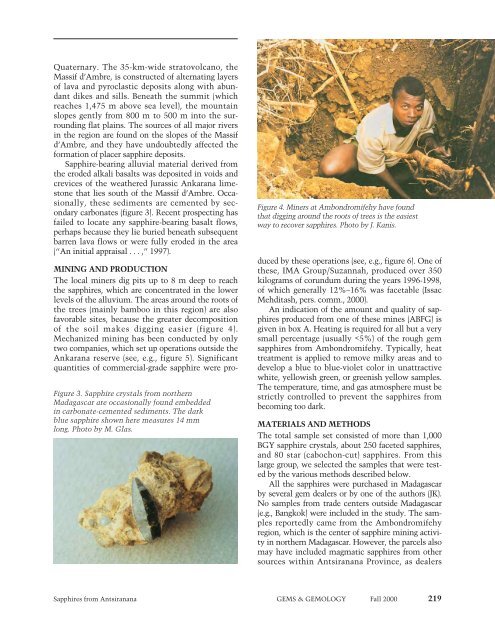Fall 2000 Gems & Gemology - Gemfrance
Fall 2000 Gems & Gemology - Gemfrance
Fall 2000 Gems & Gemology - Gemfrance
You also want an ePaper? Increase the reach of your titles
YUMPU automatically turns print PDFs into web optimized ePapers that Google loves.
Quaternary. The 35-km-wide stratovolcano, the<br />
Massif d’Ambre, is constructed of alternating layers<br />
of lava and pyroclastic deposits along with abundant<br />
dikes and sills. Beneath the summit (which<br />
reaches 1,475 m above sea level), the mountain<br />
slopes gently from 800 m to 500 m into the surrounding<br />
flat plains. The sources of all major rivers<br />
in the region are found on the slopes of the Massif<br />
d’Ambre, and they have undoubtedly affected the<br />
formation of placer sapphire deposits.<br />
Sapphire-bearing alluvial material derived from<br />
the eroded alkali basalts was deposited in voids and<br />
crevices of the weathered Jurassic Ankarana limestone<br />
that lies south of the Massif d’Ambre. Occasionally,<br />
these sediments are cemented by secondary<br />
carbonates (figure 3). Recent prospecting has<br />
failed to locate any sapphire-bearing basalt flows,<br />
perhaps because they lie buried beneath subsequent<br />
barren lava flows or were fully eroded in the area<br />
(“An initial appraisal . . . ,” 1997).<br />
MINING AND PRODUCTION<br />
The local miners dig pits up to 8 m deep to reach<br />
the sapphires, which are concentrated in the lower<br />
levels of the alluvium. The areas around the roots of<br />
the trees (mainly bamboo in this region) are also<br />
favorable sites, because the greater decomposition<br />
of the soil makes digging easier (figure 4).<br />
Mechanized mining has been conducted by only<br />
two companies, which set up operations outside the<br />
Ankarana reserve (see, e.g., figure 5). Significant<br />
quantities of commercial-grade sapphire were pro-<br />
Figure 3. Sapphire crystals from northern<br />
Madagascar are occasionally found embedded<br />
in carbonate-cemented sediments. The dark<br />
blue sapphire shown here measures 14 mm<br />
long. Photo by M. Glas.<br />
Figure 4. Miners at Ambondromifehy have found<br />
that digging around the roots of trees is the easiest<br />
way to recover sapphires. Photo by J. Kanis.<br />
duced by these operations (see, e.g., figure 6). One of<br />
these, IMA Group/Suzannah, produced over 350<br />
kilograms of corundum during the years 1996-1998,<br />
of which generally 12%–16% was facetable (Issac<br />
Mehditash, pers. comm., <strong>2000</strong>).<br />
An indication of the amount and quality of sapphires<br />
produced from one of these mines (ABFG) is<br />
given in box A. Heating is required for all but a very<br />
small percentage (usually


